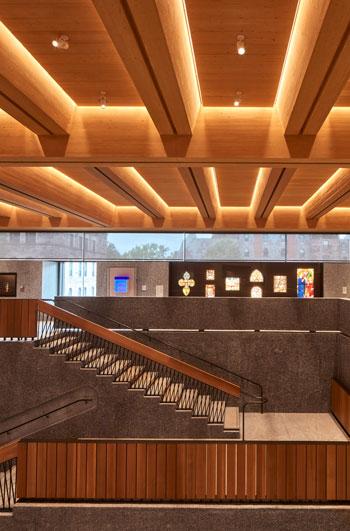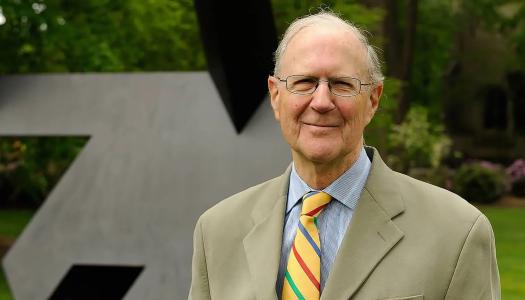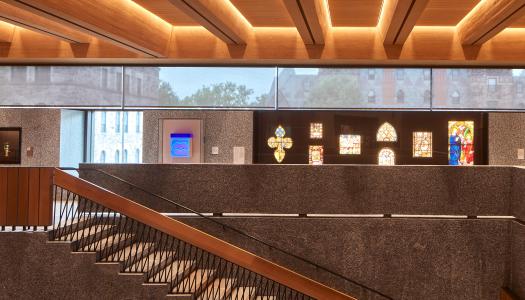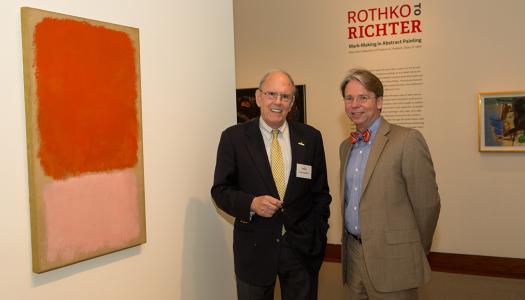The art of giving back: Susie and John Diekman ’65 help shape the new Princeton University Art Museum

Photo by Kevin Birch
When John Diekman ’65 arrived on Princeton’s campus in the fall of 1961, he had a notion of what his academic life might look like: “I wanted to do nothing but chemistry. I had a really inspiring high school chemistry teacher and Princeton had a great chemistry department.” He was quickly disabused of this idea by his adviser, who told him “Princeton is a liberal arts university, and I suggest you look at music theory, art history and more.”
Diekman signed up for his first-ever art history class, and a spark was ignited.
Today, as chair of the Princeton University Art Museum’s Advisory Council, Diekman and his wife, Susie, have played a critical role in the development of the Art Museum’s new home, a 146,000-square-foot building that has transformed the museum and amplifies its efforts to educate, challenge and inspire scholars, students and the public. Built on the site of the former museum in the heart of the campus, the new museum, which opened to the public on Oct. 31, underscores the University’s commitment to the arts and humanities.
Since the early 1980s, John and Susie Diekman have supported the University through both philanthropy and service. The chemistry major followed his passion for the field, earning a Ph.D. at Stanford University and launching a successful career in biotechnology and venture capital. Yet Diekman believes that among all his lifetime accomplishments, his leadership role on the Advisory Council stands as a pinnacle.
“To support the undertaking of a project of this scale and complexity — to be in on everything going on — was special,” he said, adding, “I can’t think of anything that would be more fun to be part of. It’s more fun than starting a company and having it do well.”
Discovering art, partnership and purpose
Diekman’s dissertation adviser at Stanford, Carl Djerassi, best known for his contribution to the development of the birth control pill, was also a successful entrepreneur — and a passionate collector of art. “When we were in the lab doing chemistry, these boxes would come in,” Diekman said. “He was collecting Paul Klee paintings.”
Diekman’s budding interest in art was fueled by his mentor’s enthusiasm — and by Susie, whom he met during his Stanford years.
Susie was an English major at Stanford, who then earned a master’s in education at the Palo Alto university in 1967. In 1968, John received his Ph.D., and the two married. They spent a year in Canberra where John was a doctoral fellow at the Australian National University’s Research School of Chemistry, and together they discovered a love of travel by exploring cultures across Asia, from Indonesia to Japan.
In 1969, they returned to California and Diekman began working at Zoecon, a company founded by Djerassi to commercialize what Diekman described in the Class of 1965’s 25th Reunion book as “birth control for insects.” The company developed a nontoxic pesticide still used today to control fleas and ticks.

Diekman’s entry in that Reunion book reveals his characteristic humility and sense of humor, as well as Susie’s impact on his interests.
“Soon after arriving at Zoecon, I jettisoned my modest scientific skills and moved into management, where other weaknesses could be more easily hidden,” he wrote. “During this time I also because an expert on the endocrinology and genitalia of cockroaches, fleas, mosquitos and even dung beetles.”
After 15 years at Zoecon, he served as president of a pharmaceutical startup and then as president of a biotechnology company focused on treating infertility. “Susie is executive director of a major corporate foundation,” his 1990 reunion entry continued. “Her professional pursuits continue to prod my volunteerism and also make participation in various cultural activities both frequent and completely enjoyable.”
As director of a telephone company’s foundation — a role she held until her retirement in 1998 — Susie managed its contributions to nonprofits in the arts. One highlight, she recalled, was when the company acquired an Ansel Adams Museum Set of 75 photographs, which they toured widely. “It debuted in the National Gallery in Washington, D.C., and it was in San Francisco, Atlanta, Rome, Amsterdam — all over the world,” Susie said. “It was my job to make that happen and to create events for our chairman to meet dignitaries in all these places.”
In 1997, John pivoted to venture capitalism in the life sciences, funding biotech entrepreneurs across the globe. In 2002, he started 5AM Ventures, where he continues to serve as founding partner.
Building a life around shared passions
Outside of their busy careers, the couple share interests in athletics, animal welfare, healthcare, and the visual and performing arts. They also collect art, starting with their first purchase: an oil painting they discovered while wandering through galleries in Scottsdale, Arizona.
“It was way too much money for us then,” Susie said with a laugh.
“And we were completely naïve,” John added. “I didn’t even know that galleries will box up the art and ship it to you.”
The Diekmans’ collection has grown to include figurative and abstract painting, photographs and sculptures.
“People ask, ’What’s your theme?’” John said. “There’s no theme.”
“This is not curated,” Susie said. “But to buy it, we do both have to like it.”
Their collecting complemented Susie’s volunteer work at Stanford’s Cantor Arts Center, where she served on the Director’s Council beginning in 2004. When John was asked to join the Princeton Art Museum’s Advisory Council in 2010, it felt like a natural fit — a blend of his own love for art, his appreciation for Princeton’s liberal arts education and his enjoyment of volunteer service with fellow alumni.
“Our council duties are to advise the Art Museum’s director,” he said. “And that could be business issues, funding issues, community issues, art issues, et cetera. It’s a thrilling group to be a part of.”
Eleven years ago, John was asked to take on the responsibility of Advisory Council chair by outgoing chair Preston Haskell ’60 and James Steward, the Nancy A. Nasher–David J. Haemisegger, Class of 1976, Director of the Art Museum, who has now held that role for 16 years.
Diekman said yes. He remembers a meeting with Haskell soon after he accepted the position. “I met with Preston and said, “‘What’s your advice?’ And he said, ‘Princeton needs a new museum.’”
The new Art Museum: Championing a bold vision
As chair of the Advisory Council, Diekman partnered with Steward to champion the new Art Museum. This work required skills in a different kind of chemistry — creating connections with fellow Tigers to help them envision an Art Museum that would be a physical manifestation of the University’s commitment to the arts and humanities.
Creating enthusiasm for the Art Museum and its mission with classmates and other alumni has been especially rewarding for Diekman. In his conversations with other alumni, he’s enjoyed sharing the Art Museum’s role as a teaching museum, with artworks spanning from neolithic times to the ultracontemporary. He likes to emphasize the “the historical, social and international perspective the Museum brings” and to help other alums see “how really special the Museum is.”
As chair of the Advisory Council, Diekman helped spread Steward’s messages that museums are for everybody and that the Princeton University Art Museum should educate, challenge and inspire students, scholars and the wider public. “The objective is to have every single student go into that museum and look around, and get exposure to art and culture and history,” he said, adding that faculty from every University department will find scholarship of interest there too.

His enthusiasm for the Art Museum is real, and contagious. In a private visit before the public opening, he was struck by its stunning architecture. “The engineers are going to be flabbergasted,” he said. “When you go into the three-story Grand Hall, you look up and see these ‘floating’ buttresses … and you see art way up there in glass cases. It’s unbelievable.”
Diekman’s admiration for Steward is clear, and Steward holds an equally strong admiration for Diekman. “In my 27 years as a museum director, John is simply one of the most extraordinary volunteers I’ve had the pleasure of knowing,” Steward said. “In 11 years as chair of our Advisory Council, through almost the whole of the project of making the new Museum, John has been a true partner in every sense. A sounding board and trusted adviser, a strategist, an advocate, a leader, a peer-to-peer fundraiser: it is hard for me to imagine what these years would have been like without him.”
Inspired by the breadth of the Art Museum’s collections, the Diekmans made a gift to name the new museum’s orientation gallery. The Susan & John Diekman Gallery offers a glimpse into the breadth of the collections by juxtaposing artworks from across place and time and engaging them in conversation with one another. The gallery is accessible to expanded hours — from 8 a.m. until 10:45 p.m. daily — enticing visitors to return and discover the depths of the Art Museum’s holdings.
A legacy of leadership, generosity and impact
The Diekmans’ vision and remarkable generosity have had a transformative impact on Princeton. Their support of the Art Museum is just one aspect of their legacy at the University, where they have supported Annual Giving and a breadth of academic opportunities and have directly impacted numerous programs and activities. Among their gifts are the Susan and John Diekman ’65 Genomics Faculty Support Fund and the Susan and John Diekman ’65 Fund for Innovative Research in Genomics. They also have supported the Van Zandt Williams, Jr., Class of 1965 Professorship in Chemistry; Princeton Athletics and more.
John has served Princeton as a member of the Board of Trustees; campaign executive committee member and super-region chair for the Aspire campaign (2008-12); an Annual Giving leadership volunteer and former co-chair of the Special Gifts Committee; and a member of the advisory councils for chemistry, genomics and the Princeton Entrepreneurship Council.
Their support is also reflected in the loan of two paintings from their personal collection for an inaugural exhibition at the museum, “Princeton Collects,” which includes artworks donated or promised by alumni. The two Wayne Thiebaud paintings are among a selection of the couple’s collection that will be bequeathed to the Art Museum.
In February 2026, the Art Museum will honor the Diekmans for their extraordinary volunteerism, leadership and philanthropy at its annual gala, which will take place in the new building.
“I am truly honored to think of John and Susie as friends,” Steward said. “The generosity of their financial support, of their gifts of art, and of their time are but three manifestations of the depth of their full-hearted commitment to the Art Museum and to Princeton.”
It’s a fitting recognition for the chemistry major whose interest in the arts and humanities was first sparked on the Princeton campus — and for the couple, whose passion for art and the Art Museum has served as inspiration for so many other alumni.


